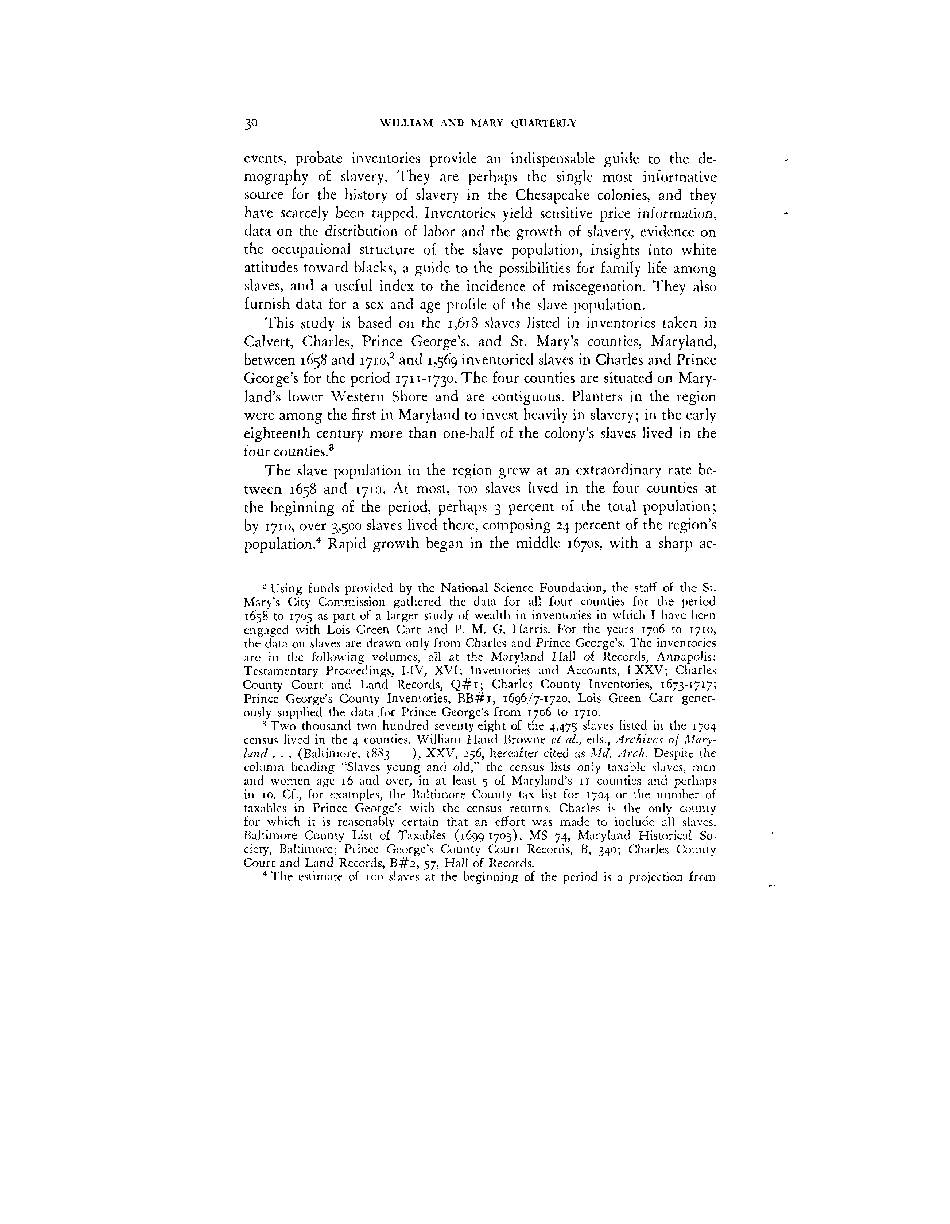|
30 WILLIAM AND MARY QUARTERLY
events, probate inventories provide an indispensable guide to the de-
mography of slavery. They are perhaps the single most informative
source for the history of slavery in the Chesapeake colonies, and they
have scarcely been tapped. Inventories yield sensitive price information,
data on the distribution of labor and the growth of slavery, evidence on
the occupational structure of the slave population, insights into white
attitudes toward blacks, a guide to the possibilities for family life among
slaves, and a useful index to the incidence of miscegenation. They also
furnish data for a sex and age profile of the slave population.
This study is based on the 1,618 slaves listed in inventories taken in
Calvert, Charles, Prince George's, and St. Mary's counties, Maryland,
between 1658 and I7io,2 and 1,569 inventoried slaves in Charles and Prince
George's for the period 1711-1730. The four counties are situated on Mary-
land's lower Western Shore and are contiguous. Planters in the region
were among the first in Maryland to invest heavily in slavery; in the early
eighteenth century more than one-half of the colony's slaves lived in the
four counties.3
The slave population in the region grew at an extraordinary rate be-
tween 1658 and 1710. At most, 100 slaves lived in the four counties at
the beginning of the period, perhaps 3 percent of the total population;
by 1710, over 3,500 slaves lived there, composing 24 percent of the region's
population.4 Rapid growth began in the middle 16705, with a sharp ac-
2 Using funds provided by the National Science Foundation, the staff of the St.
Mary's City Commission gathered the data for all four counties for the period
1658 to 1705 as part of a larger study of wealth in inventories in which I have been
engaged with Lois Green Carr and P. M. G. Harris. For the years 1706 to 1710,
the data on slaves are drawn only from Charles and Prince George's. The inventories
are in the following volumes, all at the Maryland Hall of Records, Annapolis:
Testamentary Proceedings, I-IV, XVI; Inventories and Accounts, I-XXV; Charles
County Court and Land Records, Q#i; Charles County Inventories, 1673-1717;
Prince George's County Inventories, BB#i, 1696/7-1720. Lois Green Carr gener-
ously supplied the data for Prince George's from 1706 to 1710.
3 Two thousand two hundred seventy-eight of the 4,475 slaves listed in the 1704
census lived in the 4 counties. William Hand Browne et at., eds., Archives of Mary-
land . . . (Baltimore, r883- ), XXV, 256, hereafter cited as Md. Arch. Despite the
column heading "Slaves young and old," the census lists only taxable slaves, men
and women age 16 and over, in at least 5 of Maryland's n counties and perhaps
in 10. Cf., for examples, the Baltimore County tax list for 1704 or the number of
taxables in Prince George's with the census returns. Charles is the only county
for which it is reasonably certain that an effort was made to include all slaves.
Baltimore County List of Taxables (1699-1705), MS 74, Maryland Historical So-
ciety, Baltimore; Prince George's County Court Records, B, 340; Charles County
Court and Land Records, B#2, 57, Hall of Records.
4 The estimate of 100 slaves at the beginning of the period is a projection from
�
|

